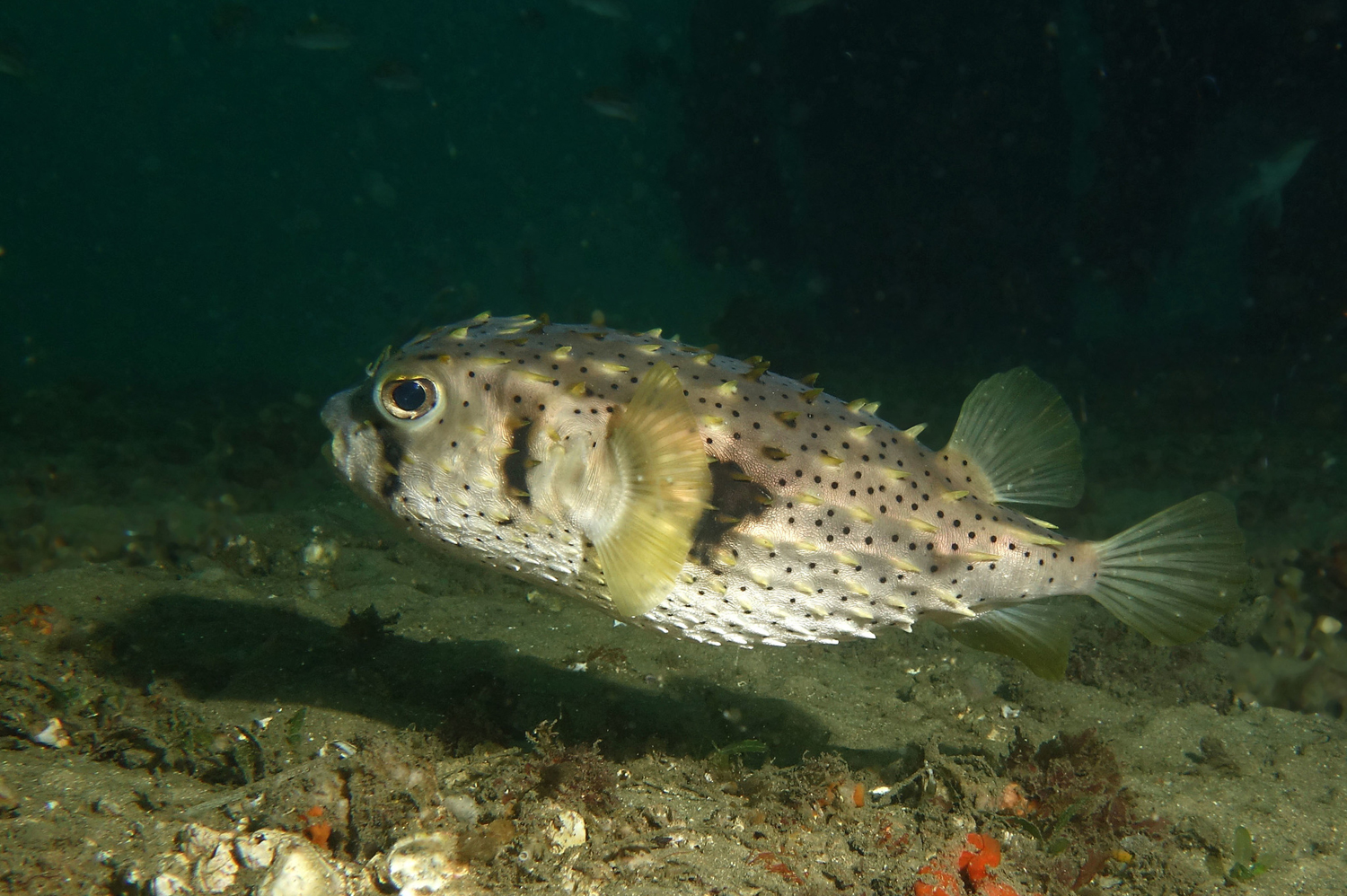Threebar Porcupinefish, Dicotylichthys punctulatus Kaup 1855
Other Names: Balloonfish, Balloon-fish, Burrfish, Burr-fish, Myer's Porcupinefish, Myer's Porcupine-fish, Spotted Porcupine Fish, Three Banded Porcupinefish, Three-bar Porcupinefish, Three-bar Porcupine-fish, Threebarred Porcupinefish, Three-barred Porcupinefish

A Threebar Porcupinefish, Dicotylichthys punctulatus, at Clifton Gardens, Sydney Harbour, New South Wales, July 2015. Source: John Turnbull / Flickr. License: CC BY Attribution-Noncommercial-ShareAlike
Summary:
A greenish to bluish-grey porcupinefish covered in small black spots, with a white belly, a dark back, three dark bars on sides - one below the eye, a second on the gill cover and a third behind the pectoral fin.
The Threebar Porcupinefish has blade-like fixed spines on the back, and movable spines on the head and belly.
Video of a Threebar Porcupinefish
The Threebar Porcupinefish has blade-like fixed spines on the back, and movable spines on the head and belly.
Video of a Threebar Porcupinefish
Cite this page as:
Bray, D.J. 2020, Dicotylichthys punctulatus in Fishes of Australia, accessed 25 Apr 2024, https://fishesofaustralia.net.au/home/species/474
Threebar Porcupinefish, Dicotylichthys punctulatus Kaup 1855
More Info
|
Distribution |
Coolum Beach, southern Queensland, to Wilsons Promontory (and occasionally west to Port Phillip), Victoria, and northern Tasmania. Inhabits estuarine, coastal and offshore reefs at depths to 50 m. |
|
Features |
Body with blade-like, fixed immovable spines, their bases having 3 roots arranged in a tripod fashion on the back, those on the belly and head able to be raised. |
|
Size |
The spines on the back are blade-like and fixed in position, but those on the belly and head can be raised. It has a very broad head, with eyes positioned laterally. The teeth are fused to form a single plate in both jaws. The species is green to blue-grey above and white below. The body is covered with small black spots. There is a dark bar under the eye, another on the operculum and a third on the body behind the pectoral fin. This species looks similar to the Spotfin Burrfish, Chilomycterus reticulatus. The latter species has spots on the fins and has fewer spines on the head and body. Although there is some overlap in distribution, the Spotfin Burrfish generally occurs in tropical waters and the Threebar Porcupinefish is found in more temperate waters of Australia's east coast. |
|
Feeding |
Feeds on benthic ionvertebrates. |
|
Similar Species |
The similar Spotfin Burrfish, Chilomycterus reticulatus has spots on the fins and fewer spines on the head and body. |
|
Etymology |
The specific name is from the Latin punctulum and -atus (= with small spots, dots), presumably in reference to the fine black spots on the body. |
|
Species Citation |
Dicotylichthys punctulatus Kaup 1855, Archiv für Naturgeschichte 21(1): 230. Type locality: Australia (although the type locality is listed as Cape of Good Hope, South Africa; Mauritius, the species is an Australian endemic) |
|
Author |
Bray, D.J. 2020 |
|
Resources |
Threebar Porcupinefish, Dicotylichthys punctulatus Kaup 1855
References
Bleeker, P. 1865. Atlas Ichthyologique des Indes Orientales Néerlandaises, publié sous les auspices du Gouvernement colonial néerlandais. Tome 5. Baudroies, Ostracions, Gymnodontes, Balistes. Amsterdam : Fréd. Müller 152 pp. pls 194-231. (described as Atopomycterus diversispinis)
Edgar, G.J. 2008. Australian Marine Life: the plants and animals of temperate waters. Sydney : Reed New Holland 2nd edn, 624 pp.
Gomon, M.F. 2008. Famiuly Diodontidae. pp. 857-858 in Gomon, M.F., Bray, D.J. & Kuiter, R.H. (eds). Fishes of Australia's Southern Coast. Sydney : Reed New Holland 928 pp.
Grant, E.M. 1975. Guide to Fishes. Brisbane : Queensland Government, Co-ordinator General’s Department 640 pp.
Hutchins, J.B. & Swainston, R. 1986. Sea Fishes of Southern Australia. Complete field guide for anglers and divers. Perth : Swainston Publishing 180 pp.
Johnson, J.W. 2010. Fishes of the Moreton Bay Marine Park and adjacent continental shelf waters, Queensland, Australia. pp. 299-353 in Davie, P.J.F. & Phillips, J.A. Proceedings of the Thirteenth International Marine Biological Workshop, The Marine Fauna and Flora of Moreton Bay. Memoirs of the Queensland Museum 54(3)
Kaup, J.J. 1855. Uebersicht über die Species einiger Familien der Sclerodermen. Archiv für Naturgeschichte 21(1): 215-233. See ref at BHL
Kuiter, R.H. 1993. Coastal Fishes of South-eastern Australia. Bathurst : Crawford House Press 437 pp.
Kuiter, R.H. 1996. Guide to Sea Fishes of Australia. A comprehensive reference for divers and fishermen. Sydney, NSW, Australia : New Holland Publishers xvii, 434 pp.
Last, P.R., Scott, E.O.G. & Talbot, F.H. 1983. Fishes of Tasmania. Hobart : Tasmanian Fisheries Development Authority 563 pp. figs.
Leis, J.M. 2001. Diodontidae. pp. 3958-3965 in Carpenter, K.E. & Niem, T.H. (eds). The Living Marine Resources of the Western Central Pacific. FAO Species Identification Guide for Fisheries Purposes. Rome : FAO Vol. 6 pp. 3381-4218.
Leis, J.M. 2006. Nomenclature and distribution of the species of the Porcupinefish family Diodontidae (Pisces, Teleostei). Memoirs of Museum Victoria 63(1): 77-90.
Marshall, T.C. 1964. Fishes of the Great Barrier Reef and Coastal Waters of Queensland. Sydney : Angus & Robertson 566 pp. 136 pls.
Matsuura, K. 2014. Taxonomy and systematics of tetraodontiform fishes: a review focusing primarily on progress in the period from 1980 to 2014. Ichthyological Research 62(1): 72-113.
Ogilby, J.D. 1910. On new or insufficiently described fishes. Proceedings of the Royal Society of Queensland 23(1): 1-55 (described as Dicotylichthys myersi) See ref at BHL










